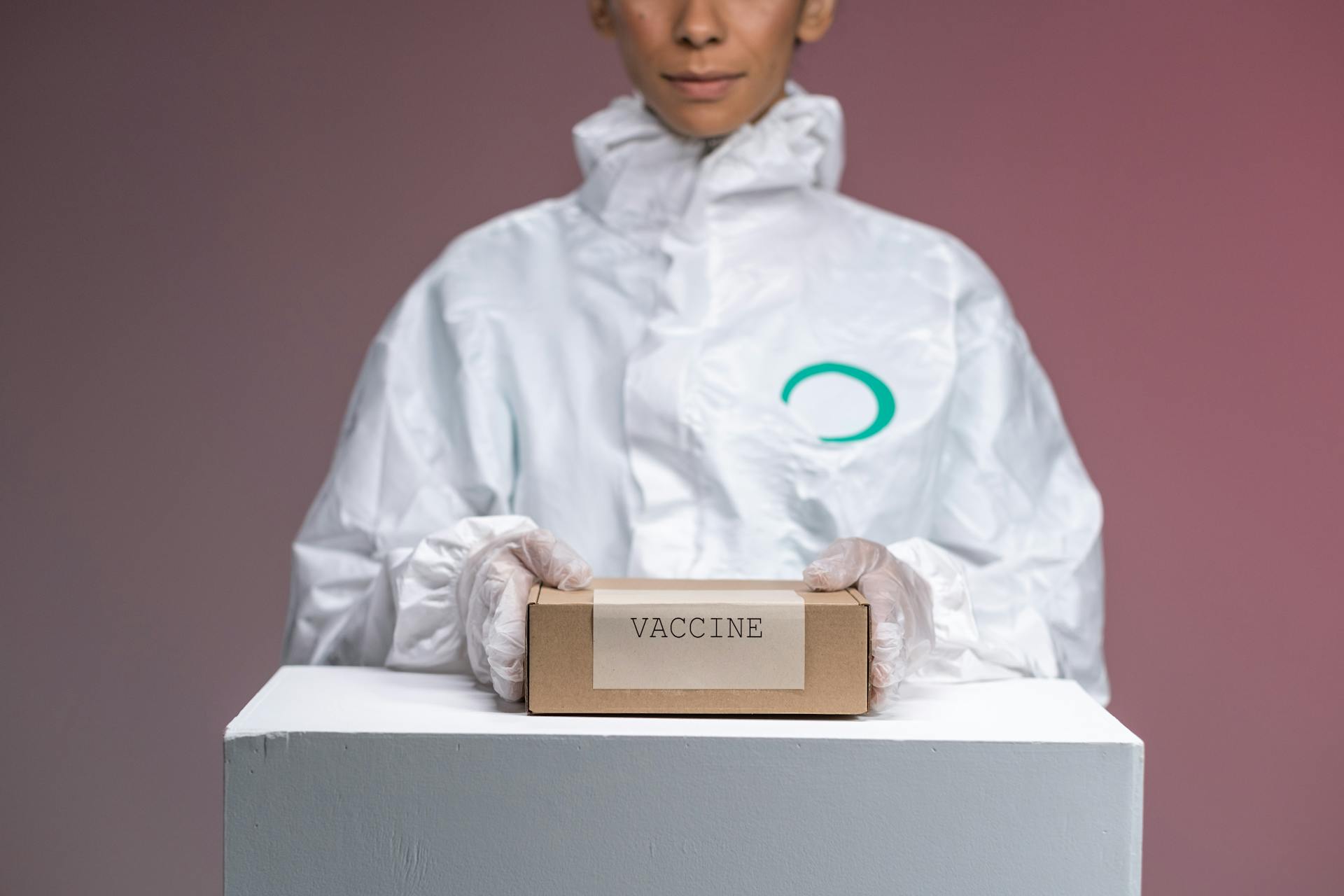
Parvo vaccination for dogs is a crucial part of their health and well-being. The parvovirus, or parvo, is a highly contagious and potentially life-threatening disease that affects dogs of all ages.
The parvo virus is usually spread through contact with an infected dog's feces, which can contaminate food and water bowls, toys, and even the air. This is why it's essential to get your dog vaccinated as soon as possible.
The parvo vaccination typically starts at 6-8 weeks of age, with a series of 3-4 shots given over the next few weeks. This helps build immunity against the virus and prevent infection.
A booster shot is usually given a year after the initial vaccination series, and then every 3 years thereafter to maintain protection.
What is Parvo?
Parvo is a highly contagious virus that affects dogs, causing severe gastrointestinal symptoms and potentially life-threatening complications.
It's most commonly spread through contact with an infected dog's feces, which can be present on surfaces, clothing, and even hands.
Parvo can survive for months in the environment, making it a persistent threat to dogs that haven't been vaccinated.
The virus attacks the lining of a dog's intestines, leading to bloody diarrhea, vomiting, and dehydration.
Symptoms can appear within 3-10 days after exposure and can be mistaken for other diseases, making prompt veterinary attention essential.
Parvo can be fatal if left untreated, with mortality rates ranging from 20-90% depending on the severity of the infection and the dog's overall health.
Young puppies are most susceptible to parvo due to their immature immune systems and lack of maternal antibodies.
Readers also liked: Dog Food Making Dogs Sick
Prevention and Vaccination
The best way to prevent parvovirus in dogs is through vaccination. Vaccination is crucial to minimize the spread and exposure to our canine companions.
Core vaccines protect dogs from common and/or severe contagious diseases, and the parvovirus vaccine is considered a core vaccine. It should be given every two to four weeks from 6–8 weeks to 16–20 weeks of age.
Here's an interesting read: Canine Distemper Shot
Puppies should only socialize with fully vaccinated dogs until they are able to be fully vaccinated themselves. Areas where your puppy can come into contact with unvaccinated dogs, such as dog parks, should be avoided.
A dog will need to receive a booster vaccine at 1 year of age to be considered fully vaccinated. Dogs should also continue to receive vaccines every one to three years for life or have their immunity monitored using parvovirus antibody tests.
Here's a summary of the recommended vaccination schedule:
Proper disinfection is crucial in preventing the spread of parvovirus, as the virus can survive in the environment for months to years. Properly diluted bleach (1:30 ratio with water) is effective when left to soak for at least 10 minutes after all organic material has been removed.
Vaccination typically starts at 8 weeks (but may start as early as 4 weeks in shelter settings) followed by a booster every 2-4 weeks until 16-20 weeks of age. A booster is given the following year, and then generally every 3 years thereafter.
Vaccination Process
The vaccination process for parvovirus (CPV-2) is a crucial step in protecting your furry friend. The recommended route for CPV-2 vaccination is via subcutaneous or intramuscular administration.
You can choose to administer the vaccine alone or in combination with other core puppy vaccinations, such as those against canine distemper virus, adenovirus, and parainfluenza virus. This combination is often referred to as a multivalent vaccine.
Puppies younger than 16 weeks should start their vaccination series at 8 to 9 weeks and receive repeat vaccinations every 3 to 4 weeks until 14 to 16 weeks of age.
For puppies in high-risk environments, an additional vaccination at 18 to 20 weeks may be beneficial. In a shelter environment, vaccines should be administered at admission and then every 2 to 3 weeks thereafter until 18 to 20 weeks of age.
Dogs older than 16 weeks that have never received a CPV-2 vaccination should receive 2 doses at 3 to 4 weeks apart.
Suggestion: Pedigree Dog Years
Diagnosis and Treatment
Diagnosing parvo in dogs typically involves a fecal SNAP ELISA test, which takes about 10 minutes and requires a fecal swab. This test is accurate, but a negative result doesn't necessarily rule out parvo in a symptomatic dog.
Further testing may be needed if a dog is showing symptoms but isn't shedding the viral antigen at the time of testing.
See what others are reading: Embark Breed & Health Dog Dna Test Stores
Symptoms
Symptoms of parvovirus in dogs can be quite severe and may start to show within three to seven days of infection. Early signs include lethargy, lack of appetite, and fever.
As the virus progresses, your dog may begin to experience abdominal pain, vomiting, and diarrhea. These symptoms can be a sign that the virus is attacking the lining of the small intestine, which can lead to serious health issues.
Very sick puppies with parvovirus may collapse, have a high heart rate, have difficulty breathing, have low white blood cell (WBC) counts, be hypothermic, or be hypoglycemic. These symptoms are a sign of a severe case of parvovirus.
Here are some common symptoms of parvovirus in dogs:
- Lethargy
- Lack of appetite
- Fever
- Abdominal pain
- Vomiting
- Diarrhea
- Collapse
- High heart rate
- Difficulty breathing
- Low white blood cell (WBC) counts
- Hypothermia
- Hypoglycemia
Transmission to Treatment
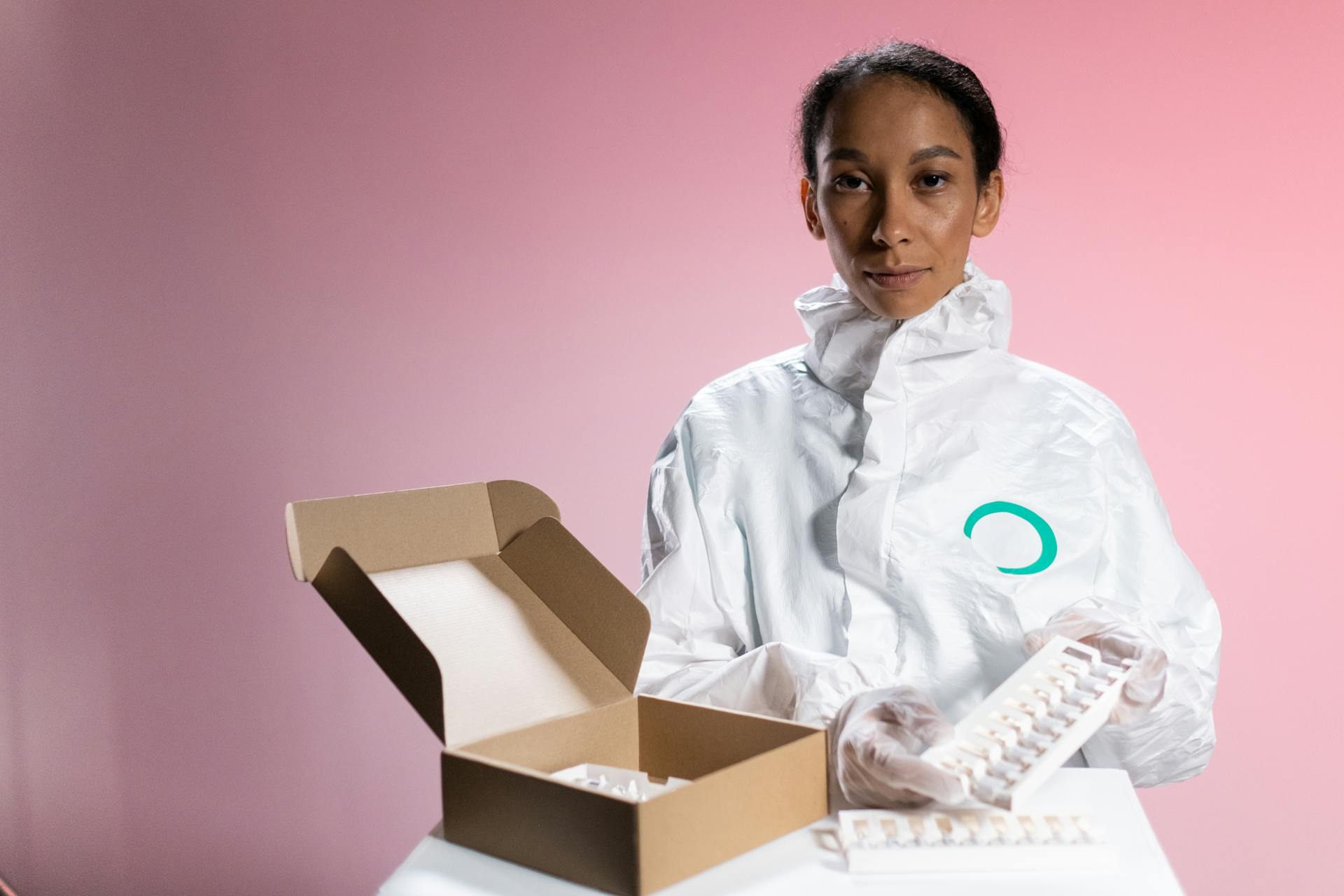
Canine parvovirus is a highly contagious and dangerous virus that affects primarily young, unvaccinated dogs.
The virus can infect unvaccinated dogs of any age, but commonly affects puppies between the age of 6 weeks to 6 months.
Parvovirus is shed in the feces of infected dogs up to two weeks before any symptoms develop, and two weeks after the signs resolve.
This means that even if you don't see any symptoms, your dog can still be carrying and spreading the virus.
The virus is hardy in the environment and resistant to many household disinfectants, making it able to survive in the right conditions for up to a year.
If left untreated, the combination of weakened immunity and overwhelming bacteria in the bloodstream can lead to life-threatening consequences and death.
Vaccination is crucial to minimize the spread and exposure to our canine companions.
On a similar theme: Symptoms of Dogs Eating Grapes
How Is Diagnosed? Tests
Diagnosing parvovirus in dogs can be a bit tricky, but there are some reliable tests to help identify the issue.
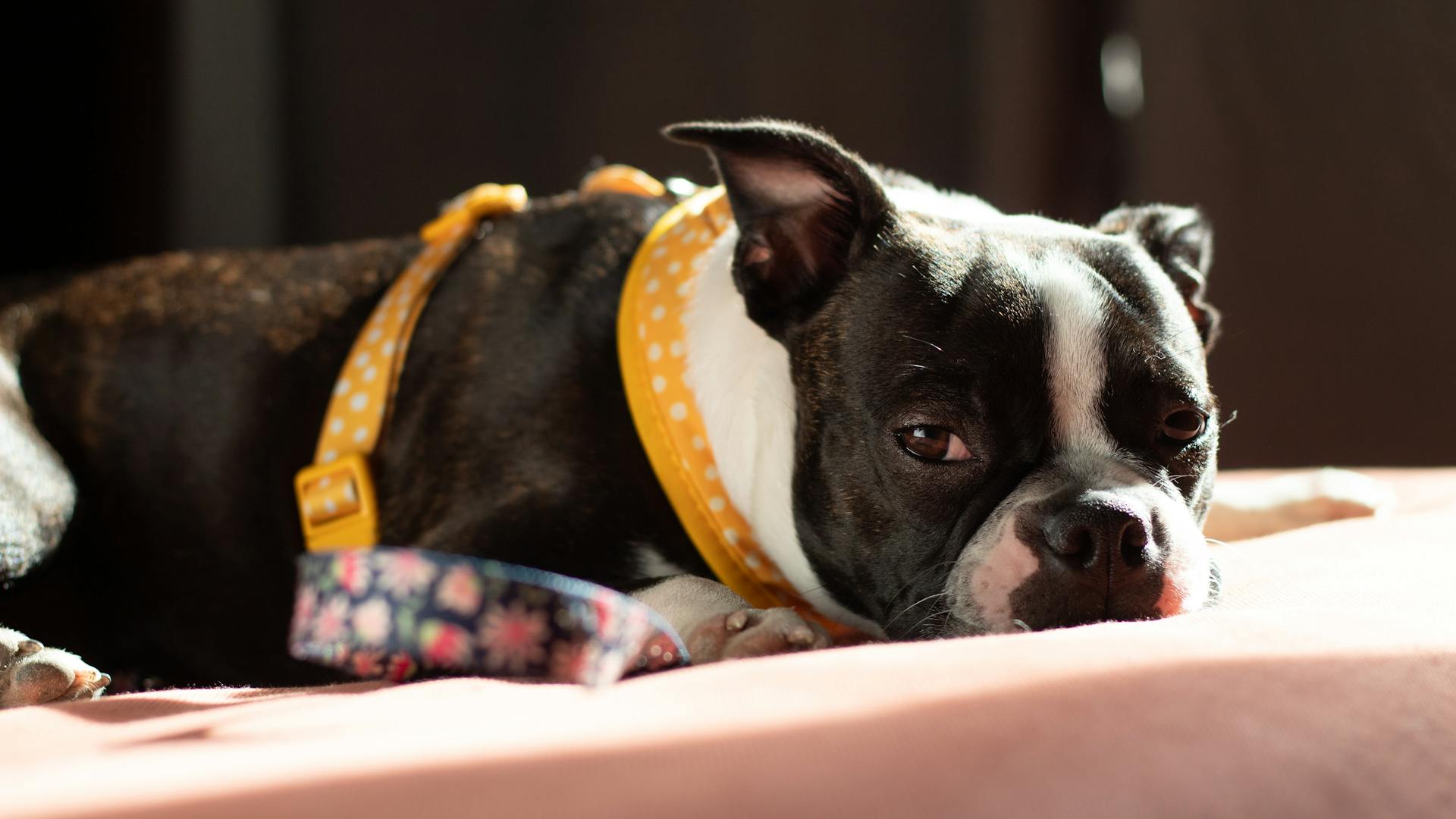
Fecal SNAP ELISA tests, also known as Parvo SNAP tests, are the most common way to diagnose parvo in dogs and puppies. These tests require a fecal swab and can provide results in about 10 minutes.
A negative test result doesn't necessarily rule out parvovirus in a symptomatic dog, as they may not be shedding the viral antigen at the time of testing. Further testing may be needed in these cases.
Antibody tests are useful for monitoring immunity to parvovirus and can be especially helpful in Rottweilers and Doberman Pinschers.
Worth a look: Canine Parvovirus Vaccine
Incubation
The incubation period of parvovirus is a critical time in the diagnosis and treatment of the disease. It's usually three to seven days before symptoms appear.
During this time, the virus is actively multiplying and seeking out rapidly dividing cells in the body. The tonsils or lymph nodes in the throat are often the first targets.
The virus then enters the bloodstream and looks for other sources of rapidly dividing cells to infect. The bone marrow and cells lining the walls of the small intestines are particularly vulnerable.
In very young puppies, parvovirus can also infect the heart, causing inflammation of the heart muscle and poor heart function. This can lead to arrhythmias.
Here are the areas most hard-hit by parvovirus:
- Bone marrow
- Cells that line the walls of the small intestines
Outcome
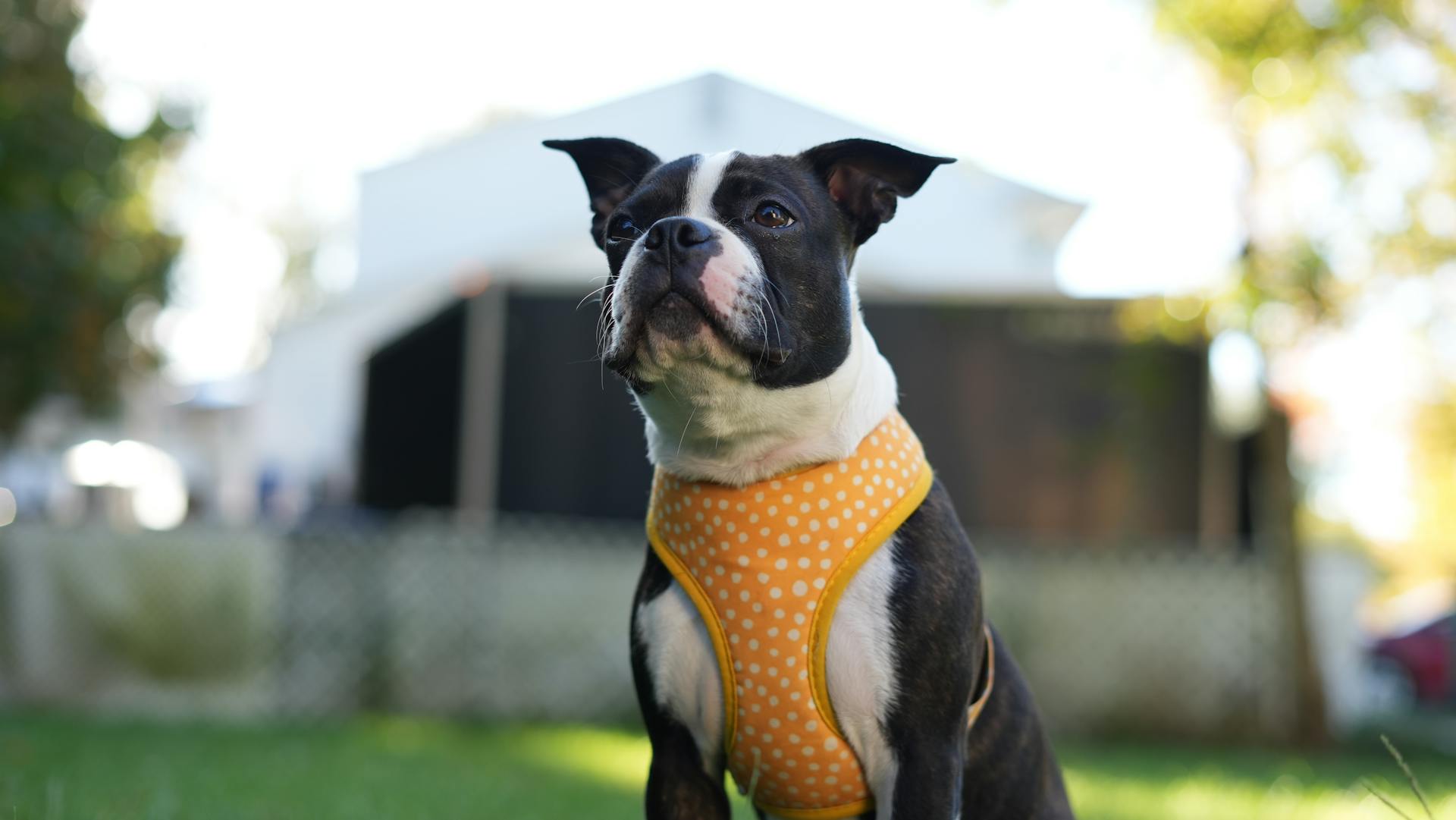
Survival from a parvovirus infection is possible, but it depends on age, size, and how sick the dog is when owners first seek care.
Most patients will not survive without treatment.
Starting medical treatments when illness first sets in will increase the likelihood of recovery.
A unique perspective: Dog Reverse Sneezing When Excited
Vaccine and Health
Core vaccines for dogs include Rabies, Canine Distemper Virus (CDV), Canine Parvovirus (CPV or parvo), and Canine Adenovirus-2 (CAV-2) – infectious hepatitis. These vaccines are recommended for almost every pet and protect dogs from common and/or severe contagious diseases.
Rabies vaccinations are required by law in most parts of the United States and are typically given as a single dose when the puppy is at least 12 weeks old. Booster vaccines are generally given to adult dogs every 1–3 years, depending on vaccine type and the dog's risk factors.
Here's a quick rundown of the core vaccines and their recommended schedules:
- Rabies: typically given as a single dose at 12 weeks old, booster shots every 1–3 years
- CDV: recommended for puppies, booster shots usually given at 3-4 week intervals until 16-20 weeks old
- CPV or parvo: recommended for puppies, booster shots usually given at 3-4 week intervals until 16-20 weeks old
- CAV-2: recommended for puppies, booster shots usually given at 3-4 week intervals until 16-20 weeks old
Vaccine Types and Mechanism
Immunity after vaccination is primarily mediated by IgG-neutralizing antibodies.
The body's immune response to vaccination involves B lymphocytes recognizing parvoviral antigen in peripheral lymphoid tissues.
These B lymphocytes undergo growth, division, and differentiation into plasma cells and memory B cells.
Plasma cells initially produce antigen-specific IgM in response to vaccine antigens.
The immune response typically matures and switches to antigen-specific IgG production.
Between 3 and 5 encounters with antigen typically lead to the differentiation of the maximal number of antigen-specific memory B cells.
Sources of Interference
Maternally derived antibodies (MDA) can neutralize vaccines, preventing the induction of durable immunity in puppies. This is because MDA are absorbed in utero and concentrated in the mammary gland during pregnancy.
The amount of vaccine inactivation is relative to the amount of MDA in circulation at the time of vaccination. Puppies with high concentrations of MDA generally exhibit a poor response to the vaccine.
The amount of MDA a puppy receives is proportional to the mother's titer and inversely proportional to the litter size. This means that larger litters will have lower concentrations of MDA.
See what others are reading: Canine Coronavirus Vaccine
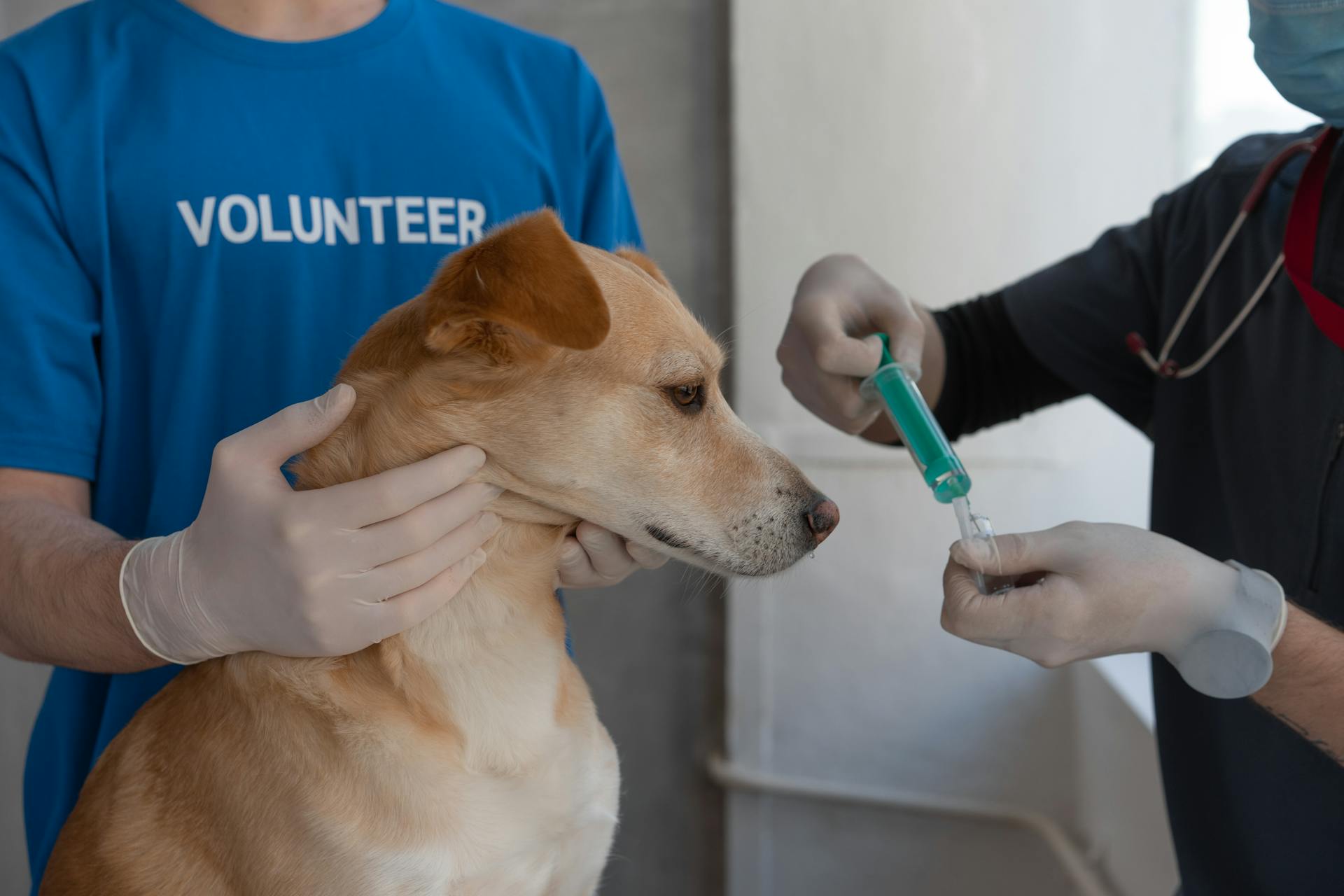
Killed or inactivated vaccines may be inadequate at inducing an immune response in the presence of MDA. This is why MLV vaccines are often preferred in puppies with MDA.
Puppies without MDA can induce immunity as soon as 3 days postvaccination with MLV vaccines. This is much faster than killed vaccines, which typically require a longer amount of time to induce immunity.
A fresh viewpoint: Dog Killed
Canine Vaccine Adverse Reactions
Severe adverse reactions to the canine parvovirus vaccine can include anaphylaxis, dermatologic signs, laryngeal and pharyngeal edema, gastrointestinal distress, collapse, cyanosis, and sudden death.
These reactions are more likely to occur after several doses of a vaccine series than after the first vaccine. Animals with a history of type I reactions or clinical signs should be monitored for 15 to 30 minutes after vaccination.
Inflammatory immune responses can result in delayed adverse reactions, including pain, pruritus, lethargy, anorexia, minor behavioral changes, and tenderness at the injection site.
These signs typically manifest 2 to 3 days after vaccination and should resolve within 12 to 24 hours.
Small-breed dogs are more susceptible to adverse reactions than large dogs, with those weighing less than 10 kg being about 4 times more likely to experience a reaction.
Dachshunds, pugs, Boston terriers, miniature pinschers, and Chihuahuas are at highest risk for development of an adverse reaction.
Receiving more than 4 vaccines during a visit can nearly double the likelihood of experiencing a reaction.
Suspected adverse vaccine reactions should be reported to the U.S. Department of Agriculture in the United States.
What Is in?
Canine parvovirus is an infectious DNA virus that commonly causes severe illness in young and unvaccinated dogs. It primarily affects the body’s rapidly dividing cells, meaning the intestinal tract and bone marrow are the most affected.
Parvovirus targets the intestinal tract, causing severe vomiting and diarrhea that can lead to dehydration and electrolyte imbalances.
Heart muscle cells of very young puppies can also be damaged by parvovirus, making it a serious health concern for this age group.
Young and unvaccinated dogs are most susceptible to parvovirus, highlighting the importance of vaccination in preventing this disease.
Frequently Asked Questions
How often do dogs need parvo shots?
Parvo shots are typically given one year after the puppy series, then every three years to maintain protection. Regular boosters are crucial to keep your adult dog safe from this highly contagious disease
At what age is a dog safe from parvo?
A dog is generally considered safe from parvo after completing a full series of vaccinations, typically by 16 weeks of age. However, it's essential to continue regular vaccinations and boosters to maintain immunity.
How much does the parvo shot cost?
The parvo shot typically costs between $30 to $40, although prices can range from $20 to $100 depending on the veterinarian and location.
Can a fully vaccinated dog get parvo?
While fully vaccinated dogs are at lower risk, they can still contract parvo if exposed. It's essential to take precautions to minimize the risk of infection, even in vaccinated dogs.
How long after a parvo shot is a puppy protected?
Full protection from parvo typically takes up to a week after the final vaccine dose, which is usually given at 3-4 week intervals
Sources
- https://todaysveterinarypractice.com/preventive-medicine/canine-parvovirus-vaccination/
- https://www.webmd.com/pets/dogs/what-is-parvovirus
- https://be.chewy.com/dog-vaccinations-a-complete-guide/
- https://www.petmd.com/dog/conditions/infectious-parasitic/parvo-in-dogs
- https://www.vet.cornell.edu/departments-centers-and-institutes/riney-canine-health-center/canine-health-information/parvovirus-transmission-treatment
Featured Images: pexels.com


